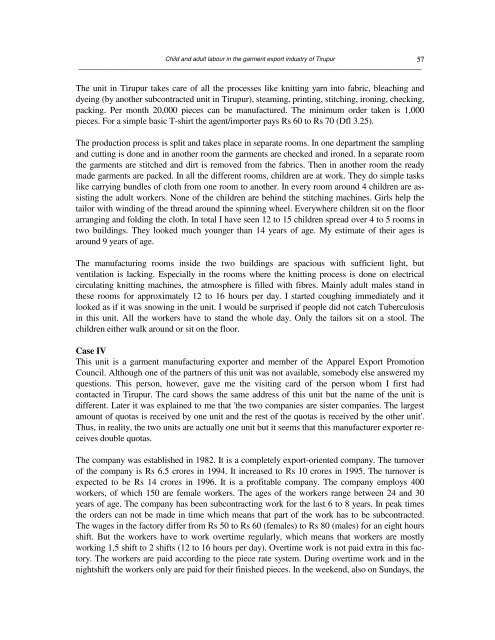You also want an ePaper? Increase the reach of your titles
YUMPU automatically turns print PDFs into web optimized ePapers that Google loves.
<strong>Child</strong> <strong>and</strong> <strong>adult</strong> <strong>labour</strong> <strong>in</strong> <strong>the</strong> <strong>garment</strong> <strong>export</strong> <strong>in</strong>dustry <strong>of</strong> Tirupur<br />
──────────────────────────────────────────────────────────────────────────────────────────────<br />
The unit <strong>in</strong> Tirupur takes care <strong>of</strong> all <strong>the</strong> processes like knitt<strong>in</strong>g yarn <strong>in</strong>to fabric, bleach<strong>in</strong>g <strong>and</strong><br />
dye<strong>in</strong>g (by ano<strong>the</strong>r subcontracted unit <strong>in</strong> Tirupur), steam<strong>in</strong>g, pr<strong>in</strong>t<strong>in</strong>g, stitch<strong>in</strong>g, iron<strong>in</strong>g, check<strong>in</strong>g,<br />
pack<strong>in</strong>g. Per month 20,000 pieces can be manufactured. The m<strong>in</strong>imum order taken is 1,000<br />
pieces. For a simple basic T-shirt <strong>the</strong> agent/importer pays Rs 60 to Rs 70 (Dfl 3.25).<br />
The production process is split <strong>and</strong> takes place <strong>in</strong> separate rooms. In one department <strong>the</strong> sampl<strong>in</strong>g<br />
<strong>and</strong> cutt<strong>in</strong>g is done <strong>and</strong> <strong>in</strong> ano<strong>the</strong>r room <strong>the</strong> <strong>garment</strong>s are checked <strong>and</strong> ironed. In a separate room<br />
<strong>the</strong> <strong>garment</strong>s are stitched <strong>and</strong> dirt is removed from <strong>the</strong> fabrics. Then <strong>in</strong> ano<strong>the</strong>r room <strong>the</strong> ready<br />
made <strong>garment</strong>s are packed. In all <strong>the</strong> different rooms, children are at work. They do simple tasks<br />
like carry<strong>in</strong>g bundles <strong>of</strong> cloth from one room to ano<strong>the</strong>r. In every room around 4 children are assist<strong>in</strong>g<br />
<strong>the</strong> <strong>adult</strong> workers. None <strong>of</strong> <strong>the</strong> children are beh<strong>in</strong>d <strong>the</strong> stitch<strong>in</strong>g mach<strong>in</strong>es. Girls help <strong>the</strong><br />
tailor with w<strong>in</strong>d<strong>in</strong>g <strong>of</strong> <strong>the</strong> thread around <strong>the</strong> sp<strong>in</strong>n<strong>in</strong>g wheel. Everywhere children sit on <strong>the</strong> floor<br />
arrang<strong>in</strong>g <strong>and</strong> fold<strong>in</strong>g <strong>the</strong> cloth. In total I have seen 12 to 15 children spread over 4 to 5 rooms <strong>in</strong><br />
two build<strong>in</strong>gs. They looked much younger than 14 years <strong>of</strong> age. My estimate <strong>of</strong> <strong>the</strong>ir ages is<br />
around 9 years <strong>of</strong> age.<br />
The manufactur<strong>in</strong>g rooms <strong>in</strong>side <strong>the</strong> two build<strong>in</strong>gs are spacious with sufficient light, but<br />
ventilation is lack<strong>in</strong>g. Especially <strong>in</strong> <strong>the</strong> rooms where <strong>the</strong> knitt<strong>in</strong>g process is done on electrical<br />
circulat<strong>in</strong>g knitt<strong>in</strong>g mach<strong>in</strong>es, <strong>the</strong> atmosphere is filled with fibres. Ma<strong>in</strong>ly <strong>adult</strong> males st<strong>and</strong> <strong>in</strong><br />
<strong>the</strong>se rooms for approximately 12 to 16 hours per day. I started cough<strong>in</strong>g immediately <strong>and</strong> it<br />
looked as if it was snow<strong>in</strong>g <strong>in</strong> <strong>the</strong> unit. I would be surprised if people did not catch Tuberculosis<br />
<strong>in</strong> this unit. All <strong>the</strong> workers have to st<strong>and</strong> <strong>the</strong> whole day. Only <strong>the</strong> tailors sit on a stool. The<br />
children ei<strong>the</strong>r walk around or sit on <strong>the</strong> floor.<br />
Case IV<br />
This unit is a <strong>garment</strong> manufactur<strong>in</strong>g <strong>export</strong>er <strong>and</strong> member <strong>of</strong> <strong>the</strong> Apparel Export Promotion<br />
Council. Although one <strong>of</strong> <strong>the</strong> partners <strong>of</strong> this unit was not available, somebody else answered my<br />
questions. This person, however, gave me <strong>the</strong> visit<strong>in</strong>g card <strong>of</strong> <strong>the</strong> person whom I first had<br />
contacted <strong>in</strong> Tirupur. The card shows <strong>the</strong> same address <strong>of</strong> this unit but <strong>the</strong> name <strong>of</strong> <strong>the</strong> unit is<br />
different. Later it was expla<strong>in</strong>ed to me that '<strong>the</strong> two companies are sister companies. The largest<br />
amount <strong>of</strong> quotas is received by one unit <strong>and</strong> <strong>the</strong> rest <strong>of</strong> <strong>the</strong> quotas is received by <strong>the</strong> o<strong>the</strong>r unit'.<br />
Thus, <strong>in</strong> reality, <strong>the</strong> two units are actually one unit but it seems that this manufacturer <strong>export</strong>er receives<br />
double quotas.<br />
The company was established <strong>in</strong> 1982. It is a completely <strong>export</strong>-<strong>oriented</strong> company. The turnover<br />
<strong>of</strong> <strong>the</strong> company is Rs 6.5 crores <strong>in</strong> 1994. It <strong>in</strong>creased to Rs 10 crores <strong>in</strong> 1995. The turnover is<br />
expected to be Rs 14 crores <strong>in</strong> 1996. It is a pr<strong>of</strong>itable company. The company employs 400<br />
workers, <strong>of</strong> which 150 are female workers. The ages <strong>of</strong> <strong>the</strong> workers range between 24 <strong>and</strong> 30<br />
years <strong>of</strong> age. The company has been subcontract<strong>in</strong>g work for <strong>the</strong> last 6 to 8 years. In peak times<br />
<strong>the</strong> orders can not be made <strong>in</strong> time which means that part <strong>of</strong> <strong>the</strong> work has to be subcontracted.<br />
The wages <strong>in</strong> <strong>the</strong> factory differ from Rs 50 to Rs 60 (females) to Rs 80 (males) for an eight hours<br />
shift. But <strong>the</strong> workers have to work overtime regularly, which means that workers are mostly<br />
work<strong>in</strong>g 1,5 shift to 2 shifts (12 to 16 hours per day). Overtime work is not paid extra <strong>in</strong> this factory.<br />
The workers are paid accord<strong>in</strong>g to <strong>the</strong> piece rate system. Dur<strong>in</strong>g overtime work <strong>and</strong> <strong>in</strong> <strong>the</strong><br />
nightshift <strong>the</strong> workers only are paid for <strong>the</strong>ir f<strong>in</strong>ished pieces. In <strong>the</strong> weekend, also on Sundays, <strong>the</strong><br />
57


















